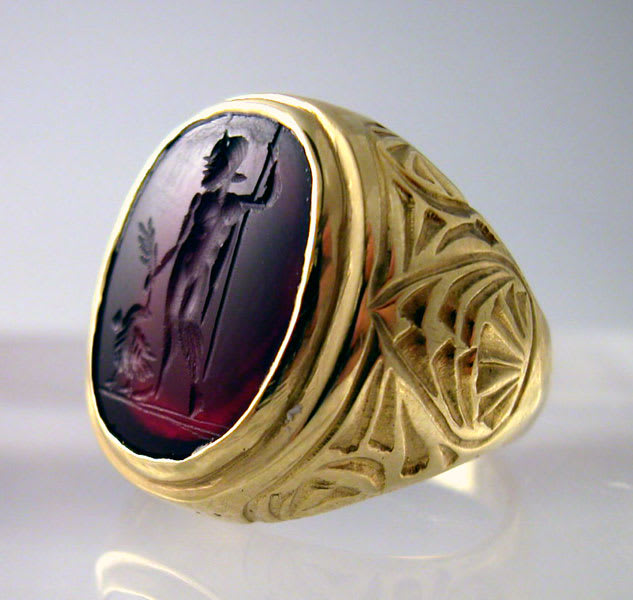Gold Ring with a Roman Carnelian Intaglio Depicting Jupiter, 100 CE - 300 CE
Gold and Carnelian
FJ.6586
The art of glyptics, or carving on colored precious stones, is probably one of the oldest known to humanity. Intaglios, gems with an incised design, were made as early as...
The art of glyptics, or carving on colored precious stones, is probably one of the oldest known to humanity. Intaglios, gems with an incised design, were made as early as the fourth and third millennia B.C. in Mesopotamia and the Aegean Islands. The exhibit a virtuosity of execution that suggests an old and stable tradition rooted in the earliest centuries. The tools required for carving gems were simple: a wheel with a belt-drive and a set of drills. Abrasives were necessary since the minerals used were too hard for a metal edge. A special difficulty of engraving intaglios, aside from their miniature size, was that the master had to work with a mirror-image in mind.
Engraved onto the polished surface of this precious stone is an image of a naked, bearded man holding a palm frond while leaning on a staff. The presence of a bird at his feet, likely an eagle, reveals the identity of this figure to be Jupiter, the king of the gods. The eagle is one of Jupiter’s main attribute and he was often known to transform into this bird of prey, according to Classical mythology. The fact that he holds a palm frond, an ancient symbol for peace, reveals that only this might deity is capable of delivering peace to mankind. During the height of the Roman Empire, this seal may have belonged to a senator or an official serving in the court of the emperor who sought to associate himself and his actions with those of Jupiter. Today, it is a reminder of the beauty and mythology of the Classical world.
Engraved onto the polished surface of this precious stone is an image of a naked, bearded man holding a palm frond while leaning on a staff. The presence of a bird at his feet, likely an eagle, reveals the identity of this figure to be Jupiter, the king of the gods. The eagle is one of Jupiter’s main attribute and he was often known to transform into this bird of prey, according to Classical mythology. The fact that he holds a palm frond, an ancient symbol for peace, reveals that only this might deity is capable of delivering peace to mankind. During the height of the Roman Empire, this seal may have belonged to a senator or an official serving in the court of the emperor who sought to associate himself and his actions with those of Jupiter. Today, it is a reminder of the beauty and mythology of the Classical world.



